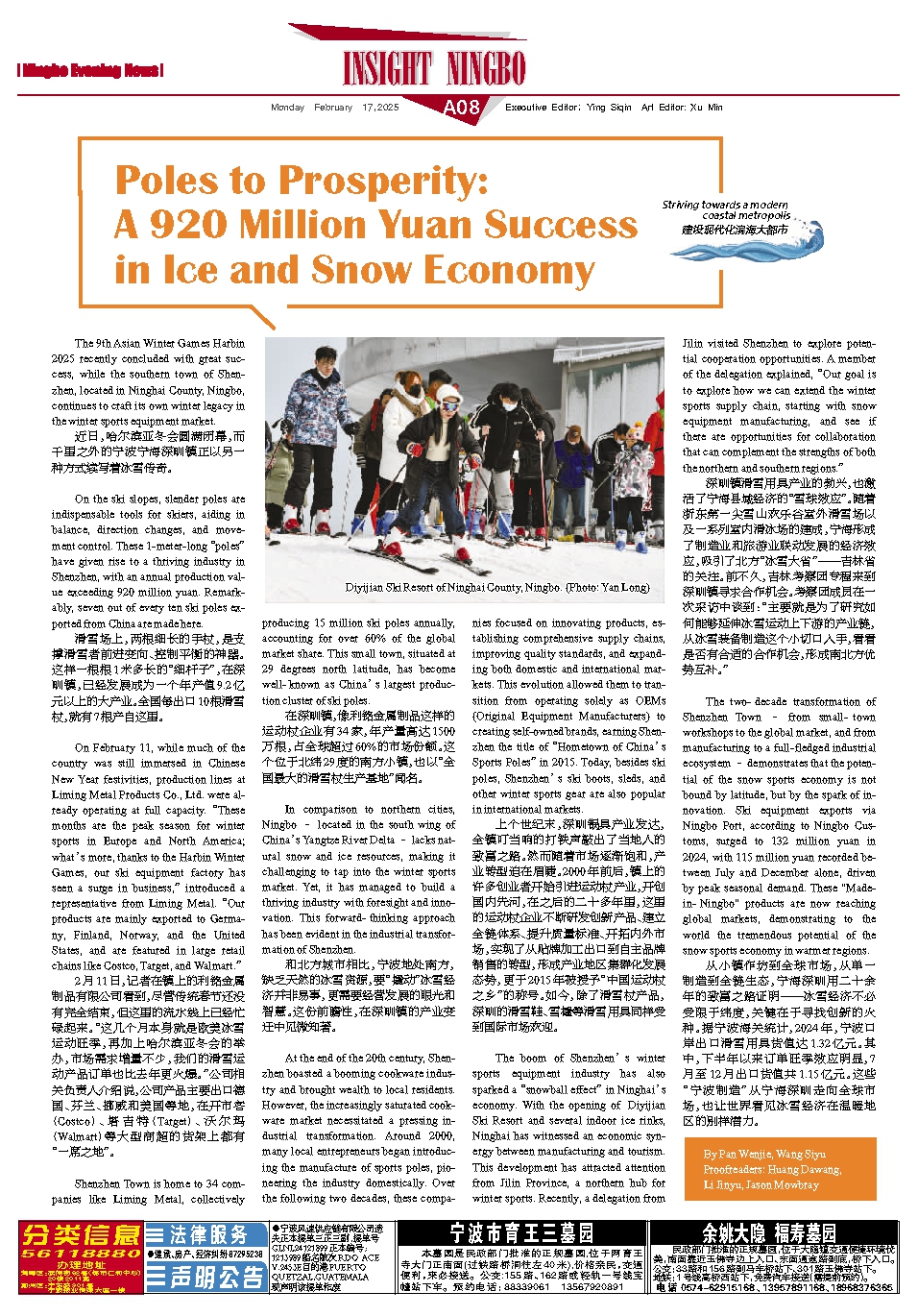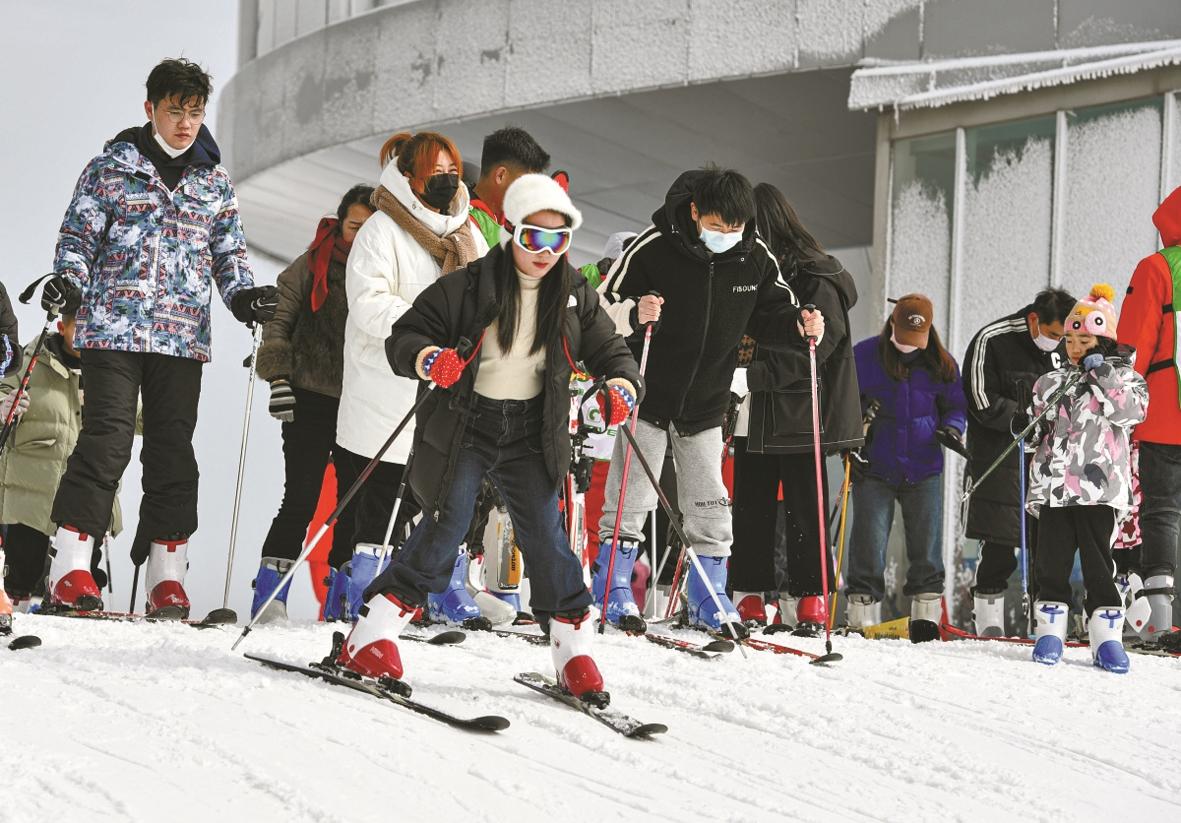The 9th Asian Winter Games Harbin 2025 recently concluded with great success, while the southern town of Shenzhen, located in Ninghai County, Ningbo, continues to craft its own winter legacy in the winter sports equipment market.
近日,哈尔滨亚冬会圆满闭幕,而千里之外的宁波宁海深甽镇正以另一种方式续写着冰雪传奇。
On the ski slopes, slender poles are indispensable tools for skiers, aiding in balance, direction changes, and movement control. These 1-meter-long “poles” have given rise to a thriving industry in Shenzhen, with an annual production value exceeding 920 million yuan. Remarkably, seven out of every ten ski poles exported from China are made here.
滑雪场上,两根细长的手杖,是支撑滑雪者前进变向、控制平衡的神器。这样一根根1米多长的“细杆子”,在深甽镇,已经发展成为一个年产值9.2亿元以上的大产业。全国每出口10根滑雪杖,就有7根产自这里。
On February 11, while much of the country was still immersed in Chinese New Year festivities, production lines at Liming Metal Products Co., Ltd. were already operating at full capacity. “These months are the peak season for winter sports in Europe and North America; what’s more, thanks to the Harbin Winter Games, our ski equipment factory has seen a surge in business,” introduced a representative from Liming Metal. “Our products are mainly exported to Germany, Finland, Norway, and the United States, and are featured in large retail chains like Costco, Target, and Walmart.”
2月11日,记者在镇上的利铭金属制品有限公司看到,尽管传统春节还没有完全结束,但这里的流水线上已经忙碌起来。“这几个月本身就是欧美冰雪运动旺季,再加上哈尔滨亚冬会的举办,市场需求增量不少,我们的滑雪运动产品订单也比去年更火爆。”公司相关负责人介绍说,公司产品主要出口德国、芬兰、挪威和美国等地,在开市客(Costco)、塔吉特(Target)、沃尔玛(Walmart)等大型商超的货架上都有“一席之地”。
Shenzhen Town is home to 34 companies like Liming Metal, collectively producing 15 million ski poles annually, accounting for over 60% of the global market share. This small town, situated at 29 degrees north latitude, has become well-known as China’s largest production cluster of ski poles.
在深甽镇,像利铭金属制品这样的运动杖企业有34家,年产量高达1500万根,占全球超过60%的市场份额。这个位于北纬29度的南方小镇,也以“全国最大的滑雪杖生产基地”闻名。
In comparison to northern cities, Ningbo – located in the south wing of China’s Yangtze River Delta – lacks natural snow and ice resources, making it challenging to tap into the winter sports market. Yet, it has managed to build a thriving industry with foresight and innovation. This forward-thinking approach has been evident in the industrial transformation of Shenzhen.
和北方城市相比,宁波地处南方,缺乏天然的冰雪资源,要“撬动”冰雪经济并非易事,更需要经营发展的眼光和智慧。这份前瞻性,在深甽镇的产业变迁中见微知著。
At the end of the 20th century, Shenzhen boasted a booming cookware industry and brought wealth to local residents. However, the increasingly saturated cookware market necessitated a pressing industrial transformation. Around 2000, many local entrepreneurs began introducing the manufacture of sports poles, pioneering the industry domestically. Over the following two decades, these companies focused on innovating products, establishing comprehensive supply chains, improving quality standards, and expanding both domestic and international markets. This evolution allowed them to transition from operating solely as OEMs (Original Equipment Manufacturers) to creating self-owned brands, earning Shenzhen the title of “Hometown of China’s Sports Poles” in 2015. Today, besides ski poles, Shenzhen’s ski boots, sleds, and other winter sports gear are also popular in international markets.
上个世纪末,深甽锅具产业发达,全镇叮当响的打铁声敲出了当地人的致富之路。然而随着市场逐渐饱和,产业转型迫在眉睫。2000年前后,镇上的许多创业者开始引进运动杖产业,开创国内先河,在之后的二十多年里,这里的运动杖企业不断研发创新产品、建立全链体系、提升质量标准、开拓内外市场,实现了从贴牌加工出口到自主品牌销售的转型,形成产业地区集群化发展态势,更于2015年被授予“中国运动杖之乡”的称号。如今,除了滑雪杖产品,深甽的滑雪鞋、雪橇等滑雪用具同样受到国际市场欢迎。
The boom of Shenzhen’s winter sports equipment industry has also sparked a “snowball effect” in Ninghai’s economy. With the opening of Diyijian Ski Resort and several indoor ice rinks, Ninghai has witnessed an economic synergy between manufacturing and tourism. This development has attracted attention from Jilin Province, a northern hub for winter sports. Recently, a delegation from Jilin visited Shenzhen to explore potential cooperation opportunities. A member of the delegation explained, “Our goal is to explore how we can extend the winter sports supply chain, starting with snow equipment manufacturing, and see if there are opportunities for collaboration that can complement the strengths of both the northern and southern regions.”
深甽镇滑雪用具产业的勃兴,也激活了宁海县域经济的“雪球效应”。随着浙东第一尖雪山欢乐谷室外滑雪场以及一系列室内滑冰场的建成,宁海形成了制造业和旅游业联动发展的经济效应,吸引了北方“冰雪大省”——吉林省的关注。前不久,吉林考察团专程来到深甽镇寻求合作机会。考察团成员在一次采访中谈到:“主要就是为了研究如何能够延伸冰雪运动上下游的产业链,从冰雪装备制造这个小切口入手,看看是否有合适的合作机会,形成南北方优势互补。”
The two-decade transformation of Shenzhen Town – from small-town workshops to the global market, and from manufacturing to a full-fledged industrial ecosystem – demonstrates that the potential of the snow sports economy is not bound by latitude, but by the spark of innovation. Ski equipment exports via Ningbo Port, according to Ningbo Customs, surged to 132 million yuan in 2024, with 115 million yuan recorded between July and December alone, driven by peak seasonal demand. These "Made-in-Ningbo" products are now reaching global markets, demonstrating to the world the tremendous potential of the snow sports economy in warmer regions.
从小镇作坊到全球市场,从单一制造到全链生态,宁海深甽用二十余年的致富之路证明——冰雪经济不必受限于纬度,关键在于寻找创新的火种。据宁波海关统计,2024年,宁波口岸出口滑雪用具货值达1.32亿元。其中,下半年以来订单旺季效应明显,7月至12月出口货值共1.15亿元。这些“宁波制造”从宁海深甽走向全球市场,也让世界看见冰雪经济在温暖地区的别样潜力。



